All about Iran's Haft-Sin: Celebrating Nowruz
Nowruz, meaning "New Day," is one of the most significant and widely celebrated festivals in Iran.
It marks the beginning of the Persian New Year and is deeply rooted in Iranian culture and traditions. Nowruz is celebrated on the vernal equinox, usually falling on March 21st, and is observed not only in Iran but also in several countries across Central Asia and the Middle East.
One of the most cherished and visually captivating traditions during Nowruz is the Haft-Sin (Haft Seen). Haft-Sin is a traditional display consisting of seven items. These symbolic items are carefully arranged on a table called the Haft Sin table or Sofreh Haft Sin.
Haft Seen holds great cultural importance as it represents various aspects of life, nature, and spirituality. Each item on the Haft-Sin table carries its own meaning and symbolism, collectively encompassing wishes for abundance, good fortune, and happiness in the coming year. It is a visual representation of hopes, aspirations, and gratitude for the blessings of the past year while welcoming a fresh start.
Haft Sin Meaning and Symbolism
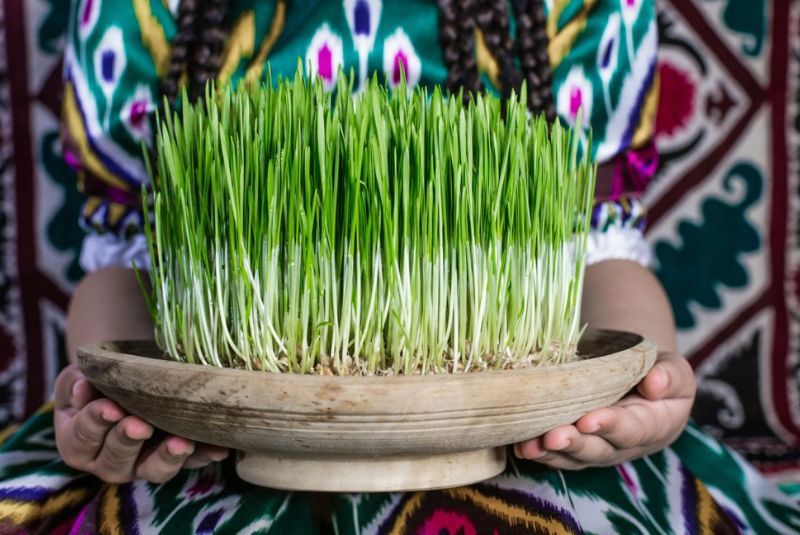
Haft-Sin is a tradition deeply embedded in Iranian culture, carrying profound symbolism and representing various aspects of life and spirituality. The term "Haft-Sin" literally translates to "Seven S's" in Persian, referring to the seven essential items that are arranged on the Haft Sin table, all starting with the letter "S" (seen) in the Persian alphabet.
Each of Haft Seen items holds its own significance and symbolism. The items commonly included in the arrangement are:
- Sabzeh (sprouts): Sabzeh refers to the sprouts of wheat, barley, or lentils that are grown prior to Nowruz. These sprouts symbolize rebirth, renewal, and the arrival of spring. They represent the fertile and ever-growing nature of life.
- Samanu (sweet pudding): Samanu is a sweet, creamy pudding made from germinated wheat. It symbolizes affluence, abundance, and the sweetness of life. Samanu reflects the rewards of patience, hard work, and the joy of harvest.
- Senjed (dried fruit): Senjed, typically the dried fruit of the oleaster tree, represents love and affection. It signifies the importance of emotional connections and fostering harmonious relationships among family and friends.
- Seeb (apple): The apple symbolizes health and natural beauty. It represents the perfection and freshness of nature. The apple also has ties to mythology, often associated with immortality and eternal youth.
- Seer (garlic): Garlic holds medicinal properties and is believed to protect against evil and negativity. It represents health, healing, and the warding off of illness. Garlic is also seen as a symbol of strength and vitality.
- Serkeh (vinegar): Vinegar represents age and patience. It signifies the wisdom and maturity acquired over time. The inclusion of vinegar serves as a reminder of the value of patience and the importance of embracing the lessons learned throughout life.
- Sumac (ground spice): Sumac is a ground spice with a tart and tangy flavor. It symbolizes the sunrise, a new beginning, and the victory of light over darkness. Sumac embodies the hope and optimism associated with the start of a new year.
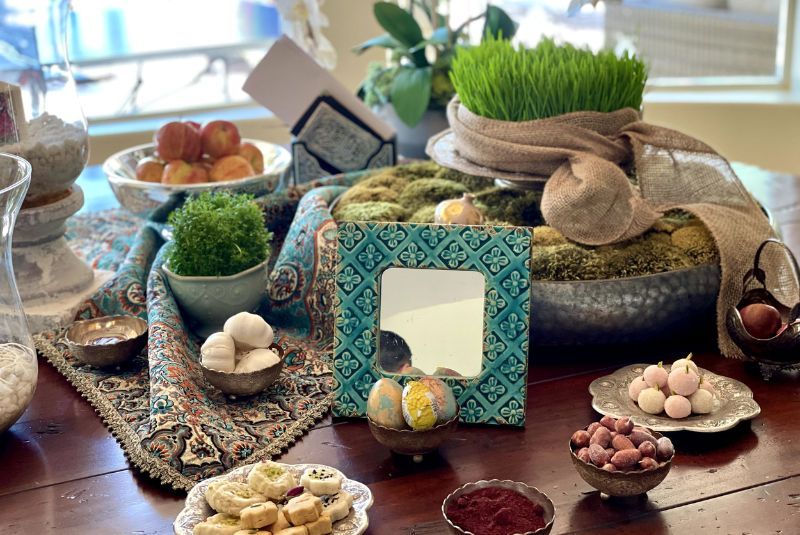
Haft Seen items collectively embody the hopes and aspirations for the coming year, encompassing themes of growth, prosperity, love, health, and spirituality. The Sofreh Haft Sin serves as a focal point for reflection, gratitude, and setting intentions for the year ahead.
| Suggestion: Everything About Nowruz!
Historical Background and Origins of Haft-Sin
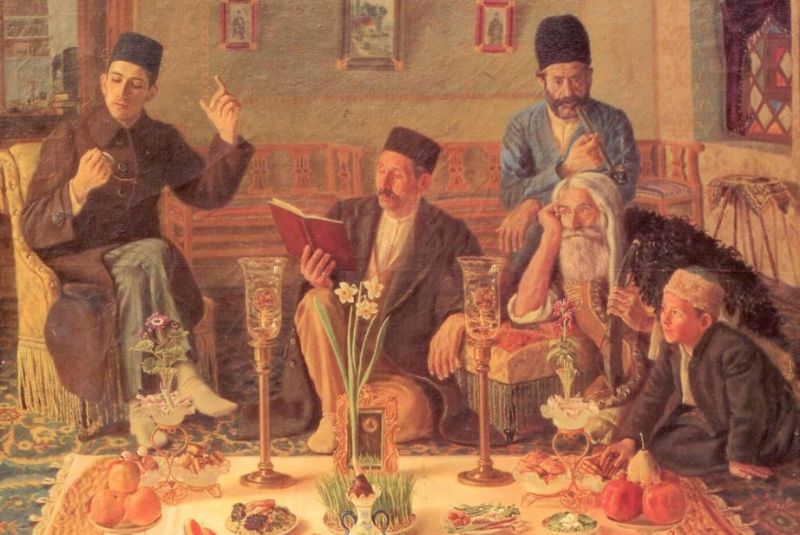
The origins of the Nowruz Haft Sin tradition can be traced back to ancient Zoroastrian rituals. Zoroastrianism, the ancient Persian religion, placed great emphasis on the veneration of nature and the celebration of the equinoxes. The Haft Sin table is believed to have originated as a way to honor and connect with the natural elements and forces.
Over time, the Haft Seen tradition evolved and became intertwined with the celebration of Nowruz. With the advent of Islam in Iran, the tradition adapted to incorporate elements from Islamic culture while preserving its ancient roots. Today, Haft Seen is cherished as a central part of Nowruz celebrations, fostering a sense of unity and continuity with the past.
Haft-Sin holds immense cultural importance in Iranian society. It is a tradition that brings families, friends, and communities together during the festive season, fostering a sense of togetherness and solidarity. The act of setting up the Haft-Sin table is a shared experience, often involving multiple generations, as they carefully arrange the items and reflect on the symbolism behind each one.
Learn More About the Iranian Ancient Festival
Setting up the Haft-Sin Table
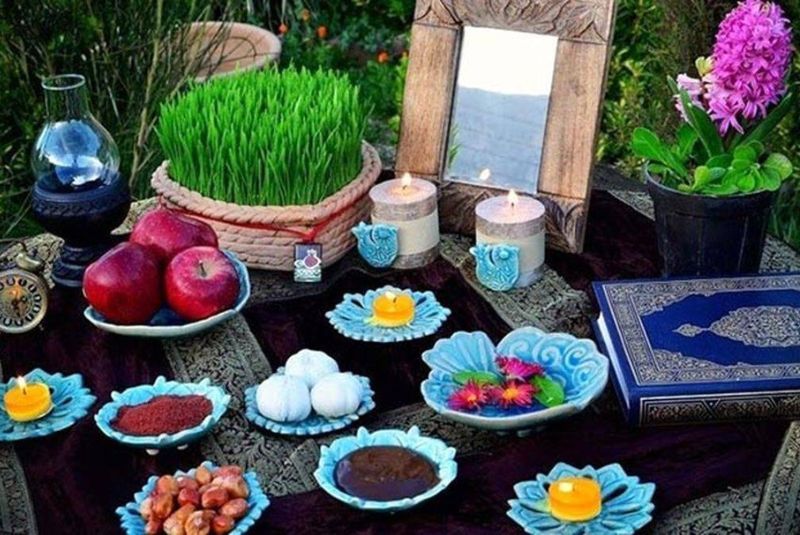
The Haft Sin set is an intricately arranged display that serves as the centerpiece of Nowruz celebrations. It is typically set up in the main living area of homes, often on a Sofreh (spread) or a cloth adorned with traditional motifs. The table is usually placed facing the direction of the sunrise, symbolizing the arrival of a new day and the beginning of the New Year.
The Sofreh Haft Sin is more than just a table; it represents a cultural canvas where creativity, artistry, and traditions come together. The cloth is often adorned with intricate patterns, embroidery, and motifs that reflect the richness of Iranian culture. It adds an additional layer of beauty and reverence to the Haft-Sin arrangement.
In addition to the seven essential items (Sabzeh, Samanu, Senjed, Seeb, Seer, Serkeh and Sumac), the Haft Sin set may feature other symbolic elements and objects. These can vary based on personal preferences, regional traditions, and individual creativity. Some common additional items include:
- Coins (Sekkeh): Coins, often placed on the Haft-Seen table, represent wealth and prosperity. They symbolize the hope for financial abundance and success in the coming year.
- Hyacinth flowers (Sonbol): Hyacinth flowers, with their delicate fragrance and vibrant colors, are frequently added to the Haft-Seen table. They symbolize spring, rebirth, and the beauty of nature.
- Decorative eggs (Tokhmeh Morgh): Decorated eggs, often painted in vibrant colors and intricate designs, represent fertility, new life, and the arrival of spring. They are a symbol of renewal and abundance.
- Holy book (such as the Quran): For religious families, a holy book, such as the Quran, may be placed on the Haft-Seen table. It serves as a reminder of spirituality, faith, and the importance of seeking guidance in the coming year.
- Candles (Sham): Candles, symbolizing enlightenment, hope, and joy, are often lit on the Haft-Seen table. They represent the triumph of light over darkness and add a warm and welcoming ambiance to the celebration.
- Mirror (Ayeneh): A mirror is a common addition to the Haft-Seen table. It represents reflection, self-awareness, and the idea of looking inward to evaluate one's actions and intentions in the past year.
- Orange (Narenj): Oranges, with their vibrant color and refreshing aroma, are frequently included on the Haft-Seen table. They symbolize prosperity, abundance, and the sweetness of life.
The arrangement of the Haft Seen items is meticulous, with each placement carrying its own significance. The specific symbolism of each item was briefly touched upon earlier. However, it is important to note that each item on the Haft Sin table represents a unique aspect of life, nature, or spirituality.
| Read about: The Fragrance Festival: Golabgiri Season in Iran
Unique Elements and Additions to Sofreh Haft-Sin
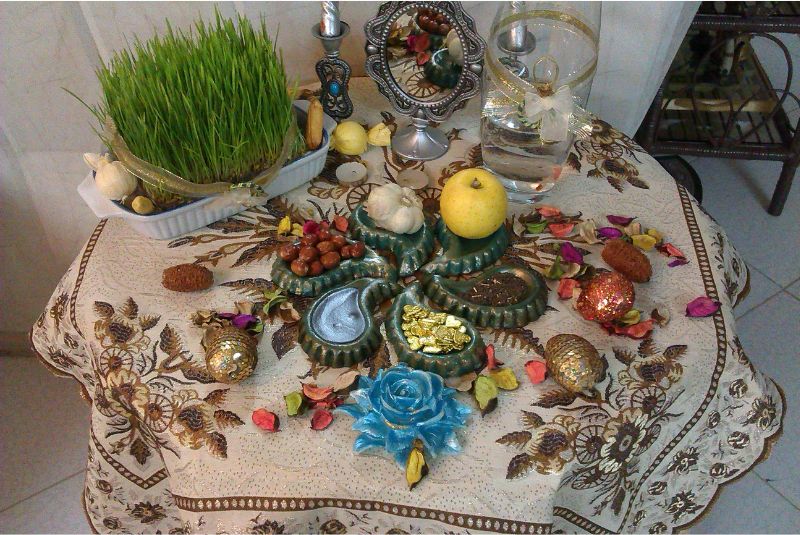
In addition to the seven essential Haft Seen items, families may choose to add unique elements and personal touches to their Sofreh Haft-Sin. These additional items can vary based on individual preferences, family traditions, and cultural backgrounds. Some examples include:
- Family heirlooms: Families may incorporate cherished items or heirlooms that have been passed down through generations. These items carry sentimental value and serve as a connection to ancestral traditions.
- Traditional handicrafts: Handcrafted items such as miniatures, ceramics, or traditional textiles may be added to the Sofreh Haft-Sin, showcasing the artistic talents and cultural heritage of the family.
- Local produce or regional specialties: Depending on the region and the availability of seasonal produce, families may include local fruits, nuts, or traditional sweets as a way to celebrate the regional flavors and culinary traditions.
- Personalized elements: Some families choose to include items that hold personal significance or represent specific interests, such as musical instruments, artistic creations, or symbols related to a profession or hobby.
These unique elements and additions further enhance the personalization and richness of the Sofreh Haft Seen, making it a reflection of individual and family identities.
| Read more: Yalda Night: An Ancient Persian Celebration
Regional Variations of Haft-Sin Traditions
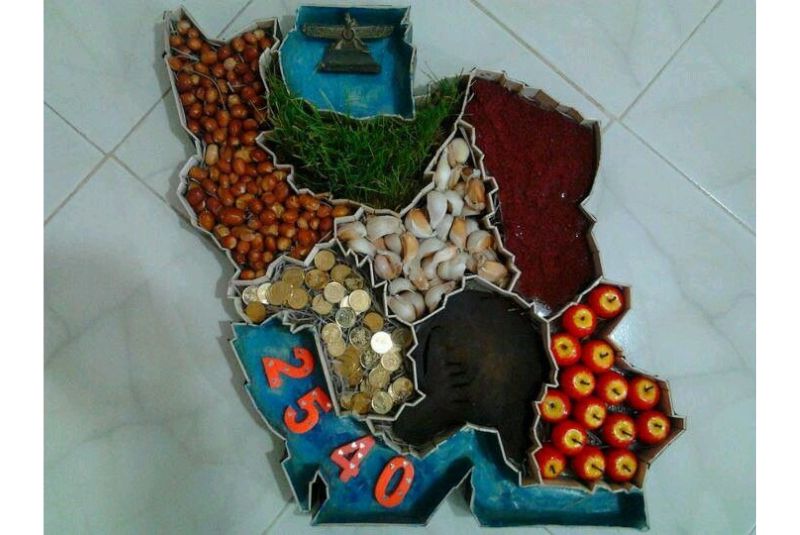
Throughout different regions of Iran, there are variations in the Nowruz Haft Sin traditions, reflecting diverse cultural practices and beliefs. Some regional variations include:
- Kerman: In Kerman, a city in southeastern Iran, a traditional element added to the Haft-Sin table is a small bowl of goldfish. The goldfish symbolizes life and is believed to bring good luck and prosperity.
- Shiraz: In Shiraz, a city renowned for its poetry and literature, the Haft-Sin table may include a book of poetry by renowned Persian poets like Hafez or Saadi. This addition emphasizes the appreciation for literature and the power of words.
- Tabriz: In Tabriz, located in northwest Iran, a special feature is the inclusion of a "divan" or a book of literary works by the famous Azerbaijani poet Nezami Ganjavi. This addition highlights the influence of Azerbaijani culture in the region.
These regional variations demonstrate the dynamic nature of Haft Seen, with each locality adding unique elements that reflect its specific customs and traditions.
| Learn About Pre-Nowruz Festival: Chaharshanbe Suri | The Festival of Fire and Renewal in Iran
Haft-Sin Rituals and Practices During Nowruz
The Haft Sin table acts as a focal point for reflection, inviting individuals to contemplate the past year, express gratitude for its blessings, and set intentions for the coming year. It is a tangible reminder of the rich cultural heritage, the values held dear, and the optimism for a prosperous and harmonious future.

Haft-Sin is accompanied by various rituals and practices that are observed during Nowruz:
- Visiting loved ones: Family members and friends visit one another's homes to exchange greetings and well wishes for the New Year. It is common to bring small gifts or tokens of appreciation.
- Making wishes: At the moment of the New Year, individuals make wishes for themselves, their loved ones, and the world. These wishes are often whispered or silently expressed while standing beside the Haft-Sin table.
- Reciting poetry: Poems and verses related to Nowruz and Haft-Sin are recited to evoke a sense of joy, celebration, and renewal. This adds to the festive atmosphere and serves as a way to pass down cultural heritage.
- Candle lighting: Candles are lit on the Haft-Sin table, symbolizing the enlightenment and illumination brought by the New Year. Each family member may take turns lighting a candle, expressing their hopes and aspirations.
| Discover: Sama Dance | A Spiritual Journey in Persian Culture
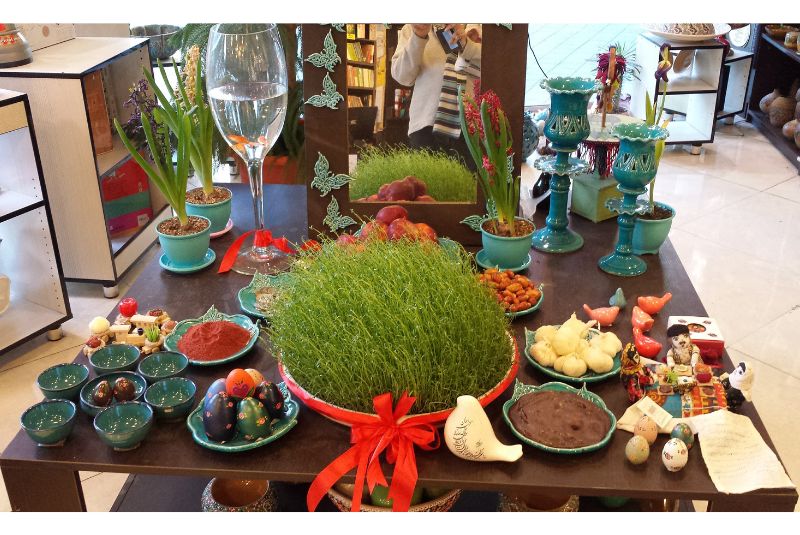
Bottom Line
Haft-Sin, an integral part of Nowruz celebrations, symbolizes renewal, hope, and the arrival of spring in Iranian culture. Each item on the Haft-Sin table carries its own meaning, representing values like fertility, abundance, wisdom, and the triumph of light over darkness. This cherished tradition connects generations, celebrating identity, unity, and cultural customs. Participating in Haft-Sin offers a chance to immerse in Iranian culture, understanding its traditions and values. With regional variations and personalization, it becomes a meaningful connection to heritage.
Share your story!
Comment below and let us know about your Experience.
Your story inspires others!


Comment
Leave a Comment